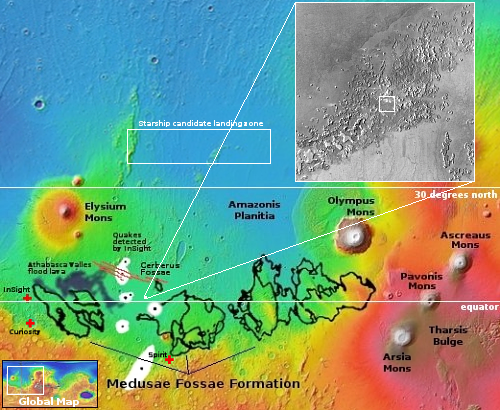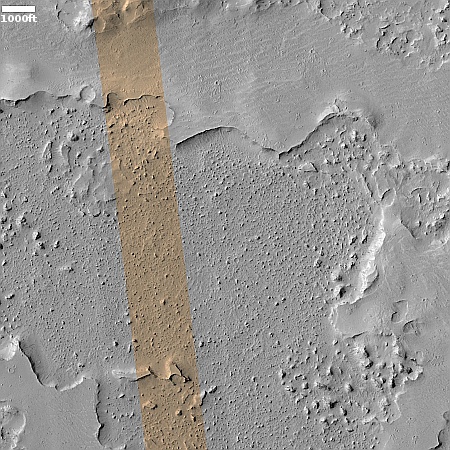Eroding lava layers in Mars’ volcano country
Cool image time! The picture to the right, cropped, reduced, and sharpened to post here, was taken on February 28, 2025 by the high resolution camera on Mars Reconnaissance Orbiter (MRO).
The scientists label this picture “enigmatic terrain.” And there are certainly mysteries here. For example, why are there scattered tiny knobs across the surface in the low areas, but not on the higher areas? Also, what caused that top layer to get stripped in places? Was it erosion from wind? Or did some other process cause that layer to vanish in these spots?
Note too that this landscape has few craters. Whatever happened here occurred recently enough that it was able to cover over the impact history from the early solar system that peppered the planets with craters as the planets formed. Though impacts continue even to this day, the impact rate is far less, which allows younger terrain like this to remain largely crater free.
The location provides us some answers, but it still leaves much of this geology a puzzlement.

The white dot on the overview map to the right marks the location, deep inside the vast flood lava plains that cover a gigantic swath of the red planet’s surface between its largest volcanoes. The spot is near the equator, inside Mars’ very dry equatorial region where no near surface ice is found. This region is also clear of the volcanic ash of the Medusae Fossae Formation to the west, south, and east. The flood lava here is also relatively old, even though young enough to have covered all the impacts from the early solar system. It is estimated that the eruptions that laid this lava down occurred sometime in that last billion years.
That age might partly explain these mysterious features. As shown in the inset, this stucco-like erosion seen in the picture above actually extends for a number of miles in all directions. It also appears to involve more than the two layers seen in the picture.
Apparently over the eons the wind of Mars stripped the top layers of this ancient lava away, with the material probably ending up as part of the ash deposits that thickly cover everything in the Medusae Fossae Formation.
On Christmas Eve 1968 three Americans became the first humans to visit another world. What they did to celebrate was unexpected and profound, and will be remembered throughout all human history. Genesis: the Story of Apollo 8, Robert Zimmerman's classic history of humanity's first journey to another world, tells that story, and it is now available as both an ebook and an audiobook, both with a foreword by Valerie Anders and a new introduction by Robert Zimmerman.
The print edition can be purchased at Amazon or from any other book seller. If you want an autographed copy the price is $60 for the hardback and $45 for the paperback, plus $8 shipping for each. Go here for purchasing details. The ebook is available everywhere for $5.99 (before discount) at amazon, or direct from my ebook publisher, ebookit. If you buy it from ebookit you don't support the big tech companies and the author gets a bigger cut much sooner.
The audiobook is also available at all these vendors, and is also free with a 30-day trial membership to Audible.
"Not simply about one mission, [Genesis] is also the history of America's quest for the moon... Zimmerman has done a masterful job of tying disparate events together into a solid account of one of America's greatest human triumphs."--San Antonio Express-News
Cool image time! The picture to the right, cropped, reduced, and sharpened to post here, was taken on February 28, 2025 by the high resolution camera on Mars Reconnaissance Orbiter (MRO).
The scientists label this picture “enigmatic terrain.” And there are certainly mysteries here. For example, why are there scattered tiny knobs across the surface in the low areas, but not on the higher areas? Also, what caused that top layer to get stripped in places? Was it erosion from wind? Or did some other process cause that layer to vanish in these spots?
Note too that this landscape has few craters. Whatever happened here occurred recently enough that it was able to cover over the impact history from the early solar system that peppered the planets with craters as the planets formed. Though impacts continue even to this day, the impact rate is far less, which allows younger terrain like this to remain largely crater free.
The location provides us some answers, but it still leaves much of this geology a puzzlement.

The white dot on the overview map to the right marks the location, deep inside the vast flood lava plains that cover a gigantic swath of the red planet’s surface between its largest volcanoes. The spot is near the equator, inside Mars’ very dry equatorial region where no near surface ice is found. This region is also clear of the volcanic ash of the Medusae Fossae Formation to the west, south, and east. The flood lava here is also relatively old, even though young enough to have covered all the impacts from the early solar system. It is estimated that the eruptions that laid this lava down occurred sometime in that last billion years.
That age might partly explain these mysterious features. As shown in the inset, this stucco-like erosion seen in the picture above actually extends for a number of miles in all directions. It also appears to involve more than the two layers seen in the picture.
Apparently over the eons the wind of Mars stripped the top layers of this ancient lava away, with the material probably ending up as part of the ash deposits that thickly cover everything in the Medusae Fossae Formation.
On Christmas Eve 1968 three Americans became the first humans to visit another world. What they did to celebrate was unexpected and profound, and will be remembered throughout all human history. Genesis: the Story of Apollo 8, Robert Zimmerman's classic history of humanity's first journey to another world, tells that story, and it is now available as both an ebook and an audiobook, both with a foreword by Valerie Anders and a new introduction by Robert Zimmerman.
The print edition can be purchased at Amazon or from any other book seller. If you want an autographed copy the price is $60 for the hardback and $45 for the paperback, plus $8 shipping for each. Go here for purchasing details. The ebook is available everywhere for $5.99 (before discount) at amazon, or direct from my ebook publisher, ebookit. If you buy it from ebookit you don't support the big tech companies and the author gets a bigger cut much sooner.
The audiobook is also available at all these vendors, and is also free with a 30-day trial membership to Audible.
"Not simply about one mission, [Genesis] is also the history of America's quest for the moon... Zimmerman has done a masterful job of tying disparate events together into a solid account of one of America's greatest human triumphs."--San Antonio Express-News


